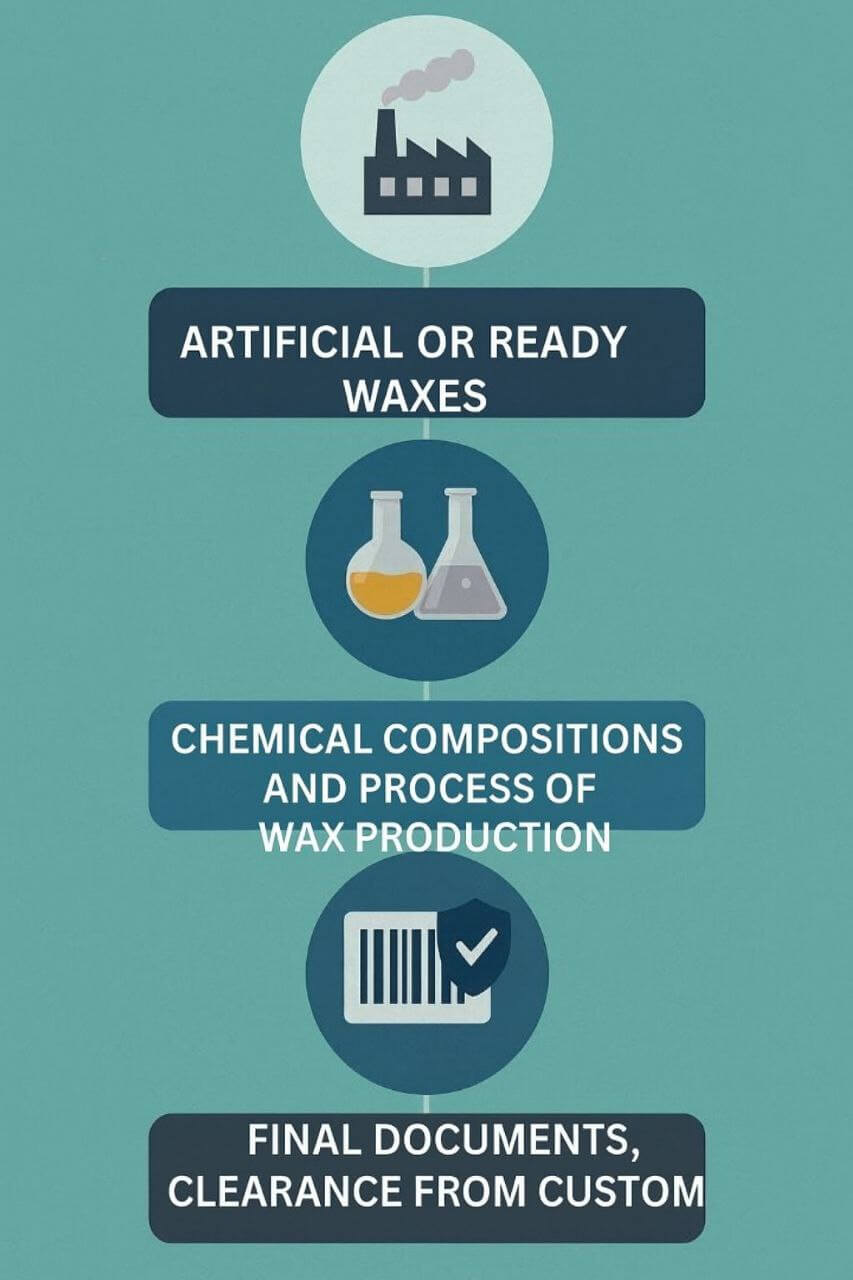Customs Clearance of Synthetic and Prepared Waxes (HS 3404 + Documents and Permits)

For estimating the time and cost of synthetic and prepared waxes clearance, contact the experts at Saba Tarkhis.
Instant Free ConsultationIntroduction and Industrial Applications
Definition of Synthetic and Prepared Waxes
Prepared waxes, on the other hand, may be derived from natural or synthetic sources. After extraction or production, they undergo refining and purification processes to meet industrial quality and safety standards. Prepared waxes may include natural options like beeswax or mineral waxes like refined paraffins, offering transparency, a fixed melting point, and oxidation resistance.
Applications of Synthetic and Prepared Waxes
Pharmaceuticals: Used in coating tablets and capsules, and in packaging due to their non-reactive properties.
Packaging: Applied as moisture-resistant coatings in food and industrial packaging, ensuring extended product shelf-life.
Chemicals and Automotive: Used in plastics, rubber production, adhesives, coatings, and automotive parts for heat and chemical resistance.
Customs Tariff and HS Code
| Product | Short Description | HS Code |
|---|---|---|
| Synthetic and Prepared Waxes | Polymeric/Petroleum-based materials for cosmetics, pharmaceuticals, packaging | 3404 |
Exact classification depends on composition, purity, origin (polymeric/petroleum/natural), and end use.
Key Clearance Steps and Notes
• Health and Standards Permits: Waxes used in cosmetics/personal-care or pharmaceutical industries require health permits and compliance certificates (e.g., from the Food & Drug Administration or the National Standards Organization).
• Customs Valuation: Accurate customs valuation must reflect international prices and market value to avoid overpayment or clearance disputes.
• Quality Control & Inspection: Upon entry, shipments may undergo conformity checks against international/national standards to ensure product safety and compliance.
Target Markets and International Trade
Germany: A leading producer for cosmetics and chemical applications.
United States: Major producer for packaging and automotive uses.
China: The largest producer with competitive pricing and varied quality.
Key importing countries include:
Iran: A principal importer, especially for packaging and cosmetics.
India and Türkiye: Fast-growing demand due to expansion in cosmetics and packaging sectors.
Documents Required for Clearance
1. Proforma Invoice
Initial quote containing product type, price, quantity, weight, and payment terms—issued by the seller.
2. Commercial Invoice
Final invoice with definitive pricing, quantities, and buyer/seller details—mandatory to initiate customs procedures.
3. Certificate of Origin
Issued by the chamber of commerce of the exporting country; crucial for duty assessment and preferences.
4. Bill of Lading (or Air Waybill)
Transport document showing consignor/consignee, cargo details, number of packages, and mode of transport.
5. Cargo Insurance Policy
Covers loss/damage risks during transit (theft, breakage, etc.).
6. Packing List
Detailed packaging breakdown: number of packages, net/gross weight, and contents to support physical inspection.
7. Health Certificate
Required when waxes are used in cosmetics, pharmaceuticals, or food-contact applications.
8. Certificate of Analysis (CoA)
Specifies composition and technical specifications; issued by the manufacturer or accredited labs.
9. Special Permits
Depending on use (cosmetic/pharma), permits from the FDA or national standards bodies may be required.
10. Customs Declaration
Accurately completed by the importer or customs broker, including value and HS Code (typically 3404).
11. Trade/Business Card
Valid importer registration issued by the chamber of commerce.
12. Warehouse Receipt
Issued upon cargo entry and storage at the customs warehouse.
13. Inspection Certificate
If stipulated by contract or required by authorities, confirming conformity with import standards.
Need precise HS classification, health/standards permits, and document preparation? Our team manages the process end-to-end.
Request a Proforma QuoteFrequently Asked Questions
What is the HS Code for synthetic and prepared waxes?
They are generally classified under 3404; final classification depends on composition, origin, and end use.
Which permits are required for clearance?
As applicable: Health Certificate, Certificate of Analysis, Certificate of Origin, and mandatory standards compliance. For cosmetics/pharma uses, FDA authorization is required.
Which industries are the main consumers?
Cosmetics & personal care, pharmaceuticals, packaging, chemicals, and automotive—enhancing durability, texture, and resistance in end products.
Premium Customs Services by Saba Brokerage
For synthetic and prepared waxes, comprehensive and specialized services are essential. Leveraging extensive experience, we provide a full suite of solutions to streamline clearance, reduce costs, and accelerate timelines.
Fast health and standards permits: Coordinated handling with authorities (e.g., FDA, standards bodies) to avoid delays.
Accurate tariffs and valuation: Expert duty assessment and value verification to prevent excess charges.
Swift, trouble-free clearance: Thorough document review, customs coordination, and inspections management.
Import/export advisory: Strategy support from sourcing country selection to final delivery, optimizing cost and efficiency.
Ongoing tracking and updates: Continuous status reporting so you can plan confidently at every step.
Clearing synthetic and prepared waxes requires deep knowledge of customs rules and tariff schedules. Partnering with our experienced team saves time and cost while ensuring compliance throughout.
.png)
